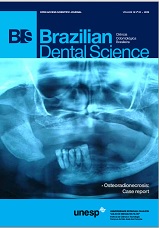Photographic assessment of hyperdivergent class II patients
DOI:
https://doi.org/10.14295/bds.2015.v18i2.1092Abstract
Temporomandibular disorders, sleep disturbances by airway obstruction and craniocervical posture changes constitute some of the problems that have been related to hyperdivergent class II patients. Although cephalometric radiographs represent the gold standard for diagnosing craniofacial morphology in clinical practice, it might not be feasible for large-scale epidemiological research. Objective: The aim of this study was to test the validity of a new photographic method in diagnosing hyperdivergent class II patients for epidemiological research purposes. Material and Methods: Lateral cephalograms and profile photographs were obtained from 123 subjects assigned into two groups. 51 patients comprised the hyperdivergent class II group and the other 72 composed a second group. Discriminant analysis described a mathematical model to better diagnose hyperdivergent class II patients through photographs. Results: A canonical discriminant function composed of two photographic variables correctly classified 85% of the hyperdivergent class II patients during internal validation (p < 0.001). The method showed 83% sensitivity and 73% specificity in external validation procedure. Conclusion: The photographic method may be a feasible and practical alternative for diagnosing the hyperdivergent class II patient, particularly if there is a need for a low-cost and noninvasive method.
Downloads
Downloads
Published
How to Cite
Issue
Section
License
Brazilian Dental Science uses the Creative Commons (CC-BY 4.0) license, thus preserving the integrity of articles in an open access environment. The journal allows the author to retain publishing rights without restrictions.
=================




























